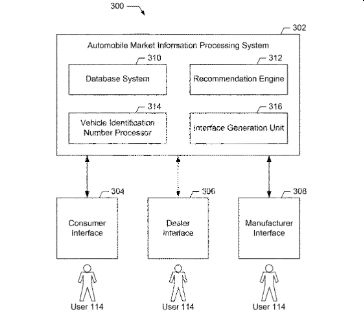[ad_1]
Anthony Fuga’s Section 101 Blog is
a must-read for anyone trying to determine the often
difficult-to-discern boundaries of subject matter that is too
abstract for patent protection. That issue is central to patenting
inventions embodied by software because software is often, by its
nature, an abstraction of the real world. Anthony’s post below
provides one example of a court rendering patented software
processes ineligible for protection under the Patent Act.
Sidekick Technology owns 12 patents broadly claiming systems,
methods and apparatuses for providing automobile market information
and performing or facilitating automobile transactions.
Looking at the 12 patents-in-suit, the U.S. District Court for
the District of New Jersey determined that they broadly
“describe flaws and inefficiencies in typical automobile
transactions caused, chiefly, by a lack of available information
… automobile transactions are routinely plagued by uncertainty,
imperfect information, and mistrust …”
The patents-in-suit purportedly solve these inefficiencies by
“creating a platform through which consumers, dealers, and
manufacturers can input, access, or filter through a range of
available automobile market data and use that data to complete
automobile transactions.” The system is designed to
efficiently match consumers with dealers, manufacturers or other
consumer automobile sellers.
Below is a representative figure from one of the 12 patents:

Vroom brought a declaratory judgment action against Sidekick and
filed a Rule 12(c) motion for judgment on the pleadings, arguing
that each of Sidekick’s relevant patents is directed to
ineligible subject matter under Section 101.
Representative Claims
The court first addressed what claim or claims are
representative of the 405 claims across all 12 patents. The court
noted that it may treat claims as representative even where the
parties do not agree to such treatment: “Less established,
however, is the appropriate framework for resolving disputes over
which claims are in fact representative.”
The court, having heard the parties’ arguments and reviewed
all 12 patents, chose one claim that includes “the major
elements and limitations argued by the parties for and against
eligibility, including, for example, the use of geolocation data
and driving directions” as well as “the additional
element of storing automobile market data,” along with
“with minor exceptions that no party has suggested bears on
the eligibility analysis.” The representative claim is
included at the bottom of this post.
Alice Step 1
At step one, the court looked at the language of the claims to
determine what the patent asserts to be the focus of the claimed
advance over the prior art, with the critical inquiry being
“whether the claims focus on a specific means or method that
improves the relevant technology or are instead directed to a
result or effect that itself is the abstract idea and merely invoke
generic processes and machinery.” The court noted that in the
context of software innovations, the inquiry “often turns on
whether the claims focus on specific asserted improvements in
computer capabilities or instead on a process or system that
qualifies [as] an abstract idea for which computers are invoked
merely as tools.”
Here, the court determined that the patents are directed to the
abstract idea of collecting and using automobile market and user
data to facilitate automobile transactions.
The representative claim “recites no more than the sort of
collection and storage of information that courts have routinely
found abstract at Alice step one,” and the remaining
claim elements “recite a computerized method of performing the
basic steps in an automobile transaction.”
Specifically, the court found that the representative claim
recited the following process:
- a consumer requests information about a specific automobile,
which includes the consumer’s geolocation information - an automobile manufacturer reviews real-time market data for
the requested automobile, including inventory data from a plurality
of dealers to determine whether the automobile can be provided to
the consumer - based on the manufacturer’s response to the consumer’s
request, a dealer in an area proximately located to the consumer
submits an inventoryless bid to sell the requested automobile - the consumer receives the bid, which includes at least price
and delivery options, as well as driving directions to the dealer
making the bid, and then selects a bid indicating an intent to
purchase the automobile
In short, the court found that the representative claim
“merely combines abstract concepts and practices to describe
the longstanding and fundamental practice of searching for and
using available market information to complete automobile
transactions.” Furthermore, the court found that the
representative claim “does not focus on or describe any
specific technological improvement … [and] the specification
makes clear that the problem the patents-in-suit are designed to
address is not one in either data collection or storage … Rather,
the specification identifies the problem as one of imperfect
information.”
Finally, the inclusion of real-time market data, geolocation
information, optical character recognition or driving directions
did not save the patents-in-suit. While those limitations may
ensure that the patents-in-suit do not preempt the entire field of
automobile transactions, the court found that “a narrow claim
directed to an abstract idea, however, is not necessarily
patent-eligible, for while preemption may signal patent ineligible
subject matter, the absence of complete preemption does not
demonstrate patent eligibility.”
Alice Step 2
The court, at step two, found that the representative claim
failed to sufficiently recite an inventive concept, even if the
claim does confer advantages over the prior art. “the Court
may assume that the techniques claimed are groundbreaking,
innovative, or even brilliant, but that is not enough for
eligibility.”
The defendant argued that the patents-in-suit were “new and
innovative” methods that offer “a synergistic and optimal
resource.” The court, however, found these statements to be
conclusory and, instead, the representative claim did not
“recite any new process, technique, or method in performing
any of the claimed features or limitations.”
The court concluded that what was claimed were “ordinary
data storage and processing functions of a computer unaccompanied
by any description or explanation of a specific or unconventional
development or implementation thereof.”
The court, accordingly, granted Vroom’s motion for judgment
on the pleadings and found all claims of the 12 patents to be
patent-ineligible under Section 101.
* * *
The representative claim reads:
A method comprising:
storing, on a computer readable medium, automobile market
data which is representative of recent automobile market
characteristics, including at least pricing data and inventory
data, wherein the automobile market data includes information
received from at least one manufacturer, a plurality of dealers,
and a plurality of consumers, wherein at least a portion of the
automobile market data is updated in real-time;
receiving, via a consumer interface, a first request for a
response regarding a first automobile, which is manufactured by a
first manufacturer, the first request made by a consumer located at
a first location and including geolocation information of the
consumer;
executing instructions, by at least one processing device,
to:
determine current inventory data of the first automobile,
wherein the current inventory data of the first automobile includes
a plurality of dealer inventories of a plurality of dealers, with
each respective dealer of the plurality of dealers having a
respective dealer inventory, and wherein the current inventory data
indicates that a first dealer of the plurality of dealers does not
currently have the first automobile in a first inventory of the
first dealer;
provide first automobile market data including the current
inventory data of the first automobile to the first manufacturer,
based on the first request, via a manufacturer interface, wherein
the first automobile market data is based on real-time automobile
market data;
generate, based on the first automobile market data
including the current inventory data of the first automobile, via
the manufacturer interface, at least one of a verification
indicating that the first automobile can be provided for the
consumer, a confirmation indicating that the first automobile can
be provided for the consumer, and an offer indicating that the
first automobile can be provided for the consumer;
determine, using the geolocation information, that the
consumer is located at the first location;
generate, based on the first location, an in-market dealer
area proximately located to the first location;
determine that the first dealer is located at a second
location within the in-market dealer area;
provide a first manufacturer response via the consumer
interface, the first manufacturer response including the at least
one of the verification indicating that the first automobile can be
provided for the consumer, the confirmation indicating that the
first automobile can be provided for the consumer, and the offer
indicating that the first automobile can be provided for the
consumer;
request, from the first dealer, via a dealer interface, an
inventory less bid to sell the first automobile based on the first
manufacturer response;
receive, from the first dealer located at the second
location and engaging in inventoryless bidding, the inventoryless
bid to provide the first automobile, which is at least one of yet
to be manufactured and in the inventory of another entity;
generate driving directions from the first location to the
second location; and provide the inventoryless bid and the driving
directions to the consumer interface, the inventoryless bid
including at least a price and a delivery option; and
receiving a consumer selection of the inventoryless bid
including a first delivery option which specifies a pickup location
at the first dealer, wherein the consumer selection indicates a
consumer intention to purchase the first automobile.
The case is Vroom Inc. v. Sidekick Tech., LLC, No.
221CV06737WJMJSA, 2022 WL 2314892 (D.N.J. June 28, 2022)
The content of this article is intended to provide a general
guide to the subject matter. Specialist advice should be sought
about your specific circumstances.
[ad_2]
Source link








